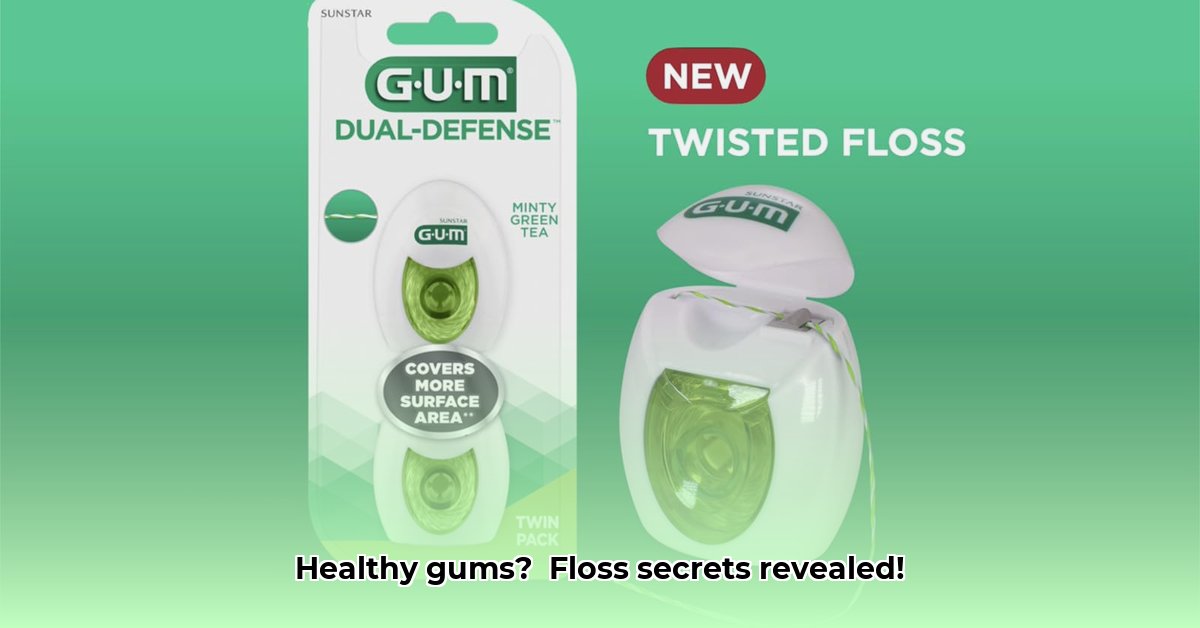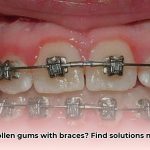Flossing. It’s often the forgotten step in our daily oral hygiene routine, but it’s a critical one for maintaining healthy gums and a bright smile. This comprehensive guide focuses specifically on GUM® dental floss, exploring the different types available, demonstrating proper flossing techniques (even for those with braces or tight teeth), and highlighting the science behind why flossing is so important for your overall well-being. For more information on dealing with gum swelling related to braces, see this helpful article: Braces and Gum Swelling. Prepare to become a flossing expert, ready to incorporate this essential habit into your daily life for a healthier, more confident smile.
The Power of GUM® Dental Floss: Your Path to Optimal Oral Health
Flossing is an essential component of any effective oral hygiene regimen. GUM® dental floss makes it easier than ever to remove plaque and debris from those hard-to-reach areas that brushing alone simply can’t address. By committing to daily flossing, you’re taking a proactive step towards preventing gum disease, tooth decay, and bad breath.
Exploring the Variety of GUM® Floss: Find Your Ideal Match
GUM® offers a diverse range of floss options to suit individual preferences and needs. Understanding the differences between these options is key to selecting the perfect floss for your unique smile:
- Waxed Floss: The smooth coating on waxed floss allows it to glide effortlessly between teeth, making it an excellent choice for individuals with tightly spaced teeth or sensitive gums. The wax minimizes friction and reduces the risk of irritation, ensuring a comfortable flossing experience.
- Unwaxed Floss: Unwaxed floss provides a slightly more textured surface, which some users find more effective at gripping and removing plaque. While it may require a bit more finesse, unwaxed floss can be a great option for those seeking a deeper clean.
- Woven Floss (e.g., GUM® Butlerweave®): Woven floss is known for its exceptional strength and resistance to shredding or breaking. This makes it an ideal choice for individuals with wider gaps between their teeth or those who tend to apply more pressure while flossing. The unique woven construction effectively removes plaque and debris without compromising the floss’s integrity.
- Expanding Floss: This type of floss expands upon contact with saliva, allowing it to reach a greater surface area between teeth. Expanding floss is particularly beneficial for individuals with uneven tooth surfaces or varying gap sizes.
The Science Behind a Healthy Smile: The Benefits of Flossing
Flossing is more than just a way to remove food particles from between your teeth. It plays a vital role in preventing plaque buildup, which is the primary cause of gum disease and tooth decay. Plaque is a sticky film of bacteria that constantly forms on our teeth. When plaque isn’t removed regularly, it can harden into tartar, which can only be removed by a dental professional.
Furthermore, research has revealed a strong connection between oral health and overall health. Studies have linked gum disease to a variety of systemic conditions, including heart disease, diabetes, and respiratory infections. By prioritizing your oral health through regular flossing, you’re also taking care of your overall well-being.
Mastering the Art of Flossing: A Step-by-Step Guide
Flossing effectively requires proper technique. Follow these steps to ensure you’re maximizing the benefits of your flossing routine:
- Prepare Your Floss: Begin by breaking off approximately 18 inches of floss. Wrap most of the floss around your middle fingers, leaving about 1-2 inches to work with.
- Gently Guide the Floss: Carefully insert the floss between your teeth using a gentle back-and-forth motion. Avoid snapping the floss into your gums, as this can cause irritation and bleeding.
- Form a “C” Shape: Once the floss is between your teeth, curve it around one tooth, forming a “C” shape.
- Clean Along the Gum Line: Gently slide the floss up and down along the tooth surface, making sure to reach slightly below the gum line. This is where plaque tends to accumulate.
- Use a Clean Section of Floss: As you move from tooth to tooth, use a clean section of floss to avoid spreading bacteria.
- Rinse Thoroughly: After flossing, rinse your mouth thoroughly with water or an antiseptic mouthwash to remove any dislodged plaque and debris.
Flossing with Braces: Flossing with braces requires a bit more patience and attention to detail. Use a floss threader to guide the floss between the wires and around each bracket. Take your time and be gentle to avoid damaging your braces.
GUM® Floss vs. Other Brands: Making an Informed Decision
While GUM® is a well-respected brand in the dental floss market, it’s important to consider other options as well. Some competing brands offer floss with unique features, such as fluoride coating or specialized textures. Ultimately, the best floss for you is the one you’re most comfortable using and that effectively removes plaque from your teeth.
| Feature | GUM® Floss Advantages | Potential Considerations |
|---|---|---|
| Strength | Durable and resistant to shredding, ensuring a thorough clean. | May feel slightly less gentle on extremely sensitive gums. |
| Variety | Wide range of options to suit different needs and preferences. | The abundance of choices can be overwhelming for some individuals. |
| Special Features | Some GUM® floss products offer unique features, such as the Butlerweave® woven design. | Special features may not be necessary for everyone. |
| Accessibility | Widely available at drugstores and online retailers. | Prices may vary depending on the retailer and the specific type of floss. |
Choosing the Right GUM® Floss for Your Needs
Selecting the best GUM® floss for your individual needs involves considering several factors:
- Gum Sensitivity: If you have sensitive gums, opt for a waxed floss or dental tape to minimize irritation.
- Tooth Spacing: If your teeth are tightly spaced, choose a thinner floss or an expanding floss to ensure easy insertion.
- Personal Preference: Ultimately, the best floss is the one you enjoy using and that you’re most likely to incorporate into your daily routine.
Addressing Common Concerns and Finding Solutions
Some individuals may experience discomfort or bleeding when they first start flossing. This is often due to inflammation caused by pre-existing gum disease. As you continue to floss regularly, the inflammation should subside, and the bleeding should decrease. If you experience persistent discomfort or bleeding, consult your dentist or dental hygienist.
Conclusion: Embrace the Power of Flossing for a Lifetime of Healthy Smiles
Flossing is an essential part of maintaining optimal oral health. By incorporating GUM® dental floss into your daily routine, you’re taking a proactive step towards preventing gum disease, tooth decay, and other oral health problems. Remember to choose the right type of floss for your needs, use proper flossing technique, and consult your dentist or dental hygienist if you have any questions or concerns. With consistent effort, you can enjoy a lifetime of healthy gums and a dazzling smile.
- Achieve Consulting Work-Life Balance: A Practical Guide - December 7, 2025
- Achieve Anesthesiology Work-Life Balance: Your Guide - December 4, 2025
- Unlock Young Doctors’ Work-Life Balance: Actionable Strategies Now - December 2, 2025
















